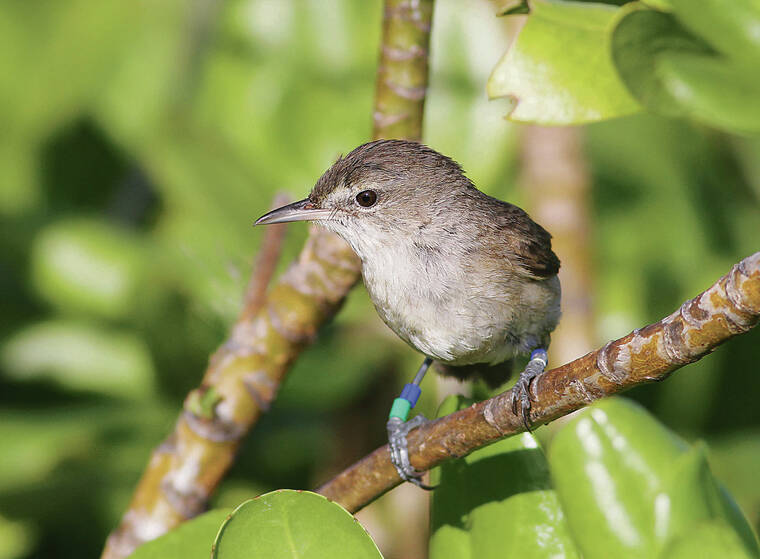The Nihoa millerbird is no longer on the brink of extinction thanks to years of conservation efforts, according to wildlife officials.
The International Union for Conservation of Nature on Monday downlisted the bird, also known as ululu, from critically endangered to endangered because a second population has been established in Hawaii.
Since 2000, IUCN Red List, a world-recognized authority, has listed the bird as critically endangered due to its small population size and restricted geographic range.
“It’s a huge milestone,” said Chris Farmer, the American Bird Conservancy’s
Hawaii program director. “Everyone who worked on this for so many years is incredibly proud. It’s a great demonstration project for what we can accomplish when we work together.”
Just over a decade ago, a few hundred of the small, brown songbirds were the only ones of their species still living on the rocky island of Nihoa.
In 2011 and 2012 the U.S. Fish and Wildlife Service, ABC and partners including the nonprofit Pacific Rim Conservation, carefully translocated 50 of the birds from Nihoa to the larger
island of Laysan in hopes of establishing a second population there as insurance against extinction.
This took years of research and planning, according to Farmer, with much of the knowledge on the millerbird’s natural biology and history established by Sheila Conant, professor emerita at the University of Hawaii at Manoa.
Laysan, about 650 miles northwest of Nihoa, was identified as an ideal place to establish a second population because it is the
second-largest landmass within the protected Papahanaumokuakea
Marine National Monument.
It was also once home to the Laysan millerbird, a closely related subspecies.
Unfortunately, the Laysan millerbird, Laysan rail and Laysan honeycreeper went extinct by the early 20th century after non-native
rabbits stripped the isle of vegetation.
After years of vegetation restoration efforts by USFWS, these invasive pests were eliminated, and Laysan has become a haven for millions of nesting seabirds and visiting migratory shorebirds.
Translocating the millerbirds was no easy task, as the team had to capture them, then carry them with care onto Zodiac boats over potentially rough seas for a journey that took three days.
The translocation was done in two phases — with roughly half moved over to Laysan in 2011 and the other half in 2012.
The newly relocated Nihoa millerbirds quickly adapted to their new home, producing new offspring.
In 2013 the population of millerbirds at Laysan doubled to more than 100, and experts estimate there are now several hundred living in all vegetated parts of the island today.
“The Millerbird translocations were an exciting, collaborative victory for Hawaiian conservation and it is immensely rewarding seeing this recognized by IUCN,” said Farmer in a news release. “The population increase on Laysan will help protect this species’ future, and shows that long-term support and commitment can prevent extinctions of any other Hawaiian birds.”
At the same time, ABC notes that Hawaii — once a bird paradise — now has the distinction of being the “bird extinction capital” of the world.
ABC says since human settlement of the Hawaiian Islands, 95 of 142 bird species found nowhere else have become extinct in the state.
Currently, 26 of Hawaii’s remaining 37 endemic birds are listed under the Endangered Species Act. Three have not been seen in decades, said ABC, while eight were recently delisted because they have been declared extinct.
Nihoa millerbirds are endemic to Hawaii and found nowhere else in the world but in Nihoa and Laysan. They are also listed as endangered under the Endangered Species Act.
The translocated population in Laysan, marked with a unique set of color bands, has been named ululu niau, which means “growing things.”

